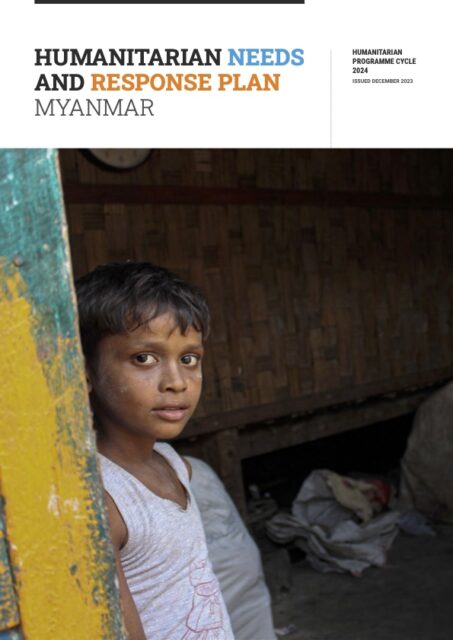Myanmar Humanitarian Needs and Response Plan 2024 (December 2023)


Executive Summary
Myanmar stands at the precipice in 2024 with a deepening humanitarian crisis that has spiralled since the military takeover in February 2021 with the civilian population that is now living in fear for their lives and whose coping capacities are stretched to the limit. The situation is now marked by surging displacement, a fragile security environment, profound protection threats, and escalating unmet needs. The humanitarian outlook remains grim, with 18.6 million people, including 6 million children, in humanitarian need – a million more than the previous year. This alarming growth is largely fuelled by protection risks and conflict, compounded by a myriad of challenges, including food insecurity, a health system in crisis, disrupted education, huge numbers of people on the move amid fears for their safety, and the aftermath of Cyclone Mocha which struck Myanmar in May 2023. The final quarter of 2023 witnessed a significant escalation in fighting resulting in a further increase in needs; elevated protection threats including death and injury from aerial bombardment, extortion, and forced labour; and new access blockages.
Conflicts and violence are expected to worsen in 2024, with increased clashes between Ethnic Armed Organizations (EAOs), People’s Defence Forces (PDFs), and the Myanmar Armed Forces (MAF). A rising tide of conflict with simultaneous fighting spreading across large swathes of the country, aggravated by targeting and harassment of civilians, restrictions on freedom
of movement and a state of emergency in place since February 2021, will continue to exacerbate the existing humanitarian and protection crises.
Myanmar’s crisis demands immediate attention and increased international support to address the multi-faceted survival challenges faced by the civilian population. Urgent funding for complementary development action is also required to reverse the growth in humanitarian need and build the resilience of communities in the face of persistent shocks.
Surging humanitarian needs
Systematic military violence against civilians, resulting in more than 4,000 deaths and tens of thousands of arbitrary arrests, underscores the urgent decision to prioritize protection in the 2024 response. Protection concerns are pervasive, as conflict-induced violence, institutionalized discrimination, human rights violations, and fear permeate daily life for the civilian population in Myanmar. Denial of access to personal legal documents further marginalizes vulnerable populations, particularly Rohingya people who have already been rendered stateless, limiting access to services, and perpetuating a cycle of discrimination.
Mass displacement continues at an alarming rate, with almost 2.6 million people displaced as of 11 December 2023 – a year-on-year increase of 1.1 million people. This displacement includes more than 660,000 people displaced by escalating conflict since 26 October 2023. People who have fled their homes and remain displaced often endure squalid conditions and inadequate shelter in formal sites or in jungles and forests. State Administration Council (SAC) actions and policies aimed at camp closures, premature returns, and relocations are amplifying protection challenges for affected internally displaced persons (IDPs), while a heightened risk of smuggling, human trafficking, and an exodus of young people seeking safety and opportunities abroad looms large.
The confluence of a non-functional health system and increasing health vulnerabilities among large sections of the population has led to deteriorating maternal and child health outcomes, a lagging emergency care response, and dangerously low routine immunizations with potential regional implications. Children are bearing the brunt of the crisis with interruptions to their health care and schooling, as well as exposure to a range of protection and mental health risks. Approximately a third of school-age children are not enrolled in any form of learning, and conflict, displacement, and economic hardships have severely disrupted education over the past three years with life-long impacts on the children of Myanmar. Malnutrition is feared to be spreading as large swaths of the population continue to experience high levels of food insecurity and treatment supplies are increasingly difficult for humanitarians to import into the country.
Myanmar is highly exposed to natural hazards including cyclones and flooding and globally ranks as the country that is second-most affected by extreme climate events, exposing the population to additional dangers. At least 28 million people (or half the population) are living in districts at high flood exposure risk. Extremely Severe Cyclone Mocha in May 2023 affected more than 3 million people. Lack of timely humanitarian access to those affected exacerbated pre-existing vulnerabilities and increased people’s dependency on aid, with flow-on impacts for needs in 2024.
The crisis in Myanmar is disproportionately affecting women, perpetuating gender disparities in employment and increasing vulnerability to trafficking, gender- based violence (GBV), including sexual exploitation and harassment(SEA). Widespread discrimination on ethnic and religious grounds play a significant role . Persons with disabilities are especially vulnerable in the conflict and violence affecting the country, as well as natural disasters.

